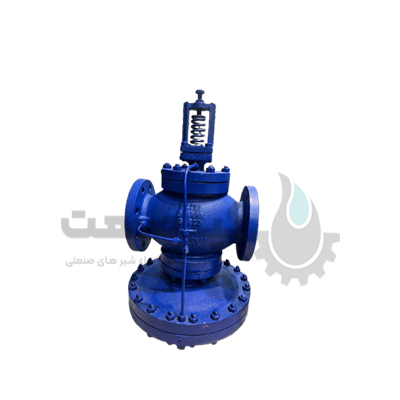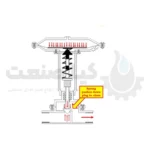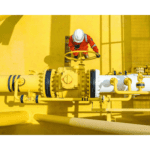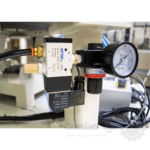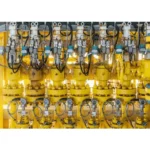Hydraulic and pneumatic are two different ways to move machines. In both cases, a pump and actuator are used. The difference between the two is in the material under pressure and the specific application.
Hydraulic systems and pneumatic systems are widely used and seen everywhere every day.
The principle of hydraulic and pneumatic systems is to apply pressure, but there is only one difference: hydraulics are controlled by oil, and pneumatics work with air pressure.
Hydraulic
Hydraulics uses a compressible fluid such as mineral oil, ethylene glycol, water, or fire-resistant movements at high temperatures to help control and transmit power.
Hydraulic systems require a pump and, like pneumatic systems, use special valves to control the power and speed of actuators.
Hydraulics are used at 65 bar to 345 bar or more than 700 bar for specialized applications.
The word hydraulic is derived from the Greek words hydor (water) and aulos (pipe). A hydraulic system consists of a cylinder, piston, various pumps and valves that control the flow direction and of course the compressed fluid.
Hydraulic systems are generally larger and more complex than pneumatic systems and require more space because a large container is required to hold the fluid.
Larger size comes with more pressure, which often makes a hydraulic system more expensive than a pneumatic one.
Hydraulic systems are also slower than pneumatic systems because the oil is thicker and requires more energy to move through the pipes.
Examples of hydraulic applications include:
Elevator
- dams
machinery
Amusement park rides
Wind turbines
Wheelchair lift
Digging arms for shovels
Forged metal parts
Wing flaps in airplanes
Hydraulic brake system in cars
Lift the car
PneumaticPneumatics uses a compressed gas such as air or other pure compressible gases instead of liquids and can be used to affect the mechanical movement of small hand-held devices and large machines.A pneumatic system consists of several components, including air tanks, gas compressors, transmission lines, cylinders, hoses, and of course the gas itself.Electron valves regulate air flow and convert gas into mechanical energy.The pneumatic system is mainly used with a pressure of about 5.5 bar to 6.9 bar.
Compressed air is stored in storage tanks before use.
In pneumatic systems, it is mainly used for shock absorption.
You often see pneumatic applications in sectors such as construction, robotics, food production and distribution, medical applications, mining, biotechnology, transportation and manufacturing.
Examples of pneumatic tools are:
Air compressors
Vacuum pumps
HVAC control systems
Compressed air engines and vehicles
Pressure sensors, switches and pumps
Conveyor belt systems in pharmaceutical and food industries
Air brakes used by buses, trucks and trains
Production and assembly lines
Pneumatic motors, tires and tools
Advantages of hydraulic systems
The use of hydraulic systems has many benefits and advantages, because hydraulic systems play an important role in heavy industries. Here are some advantages:
High power density
Hydraulics have a higher power density due to the oil inside the cylinder so that the pressure will be constant, and the application will be higher in any condition.
Precise control
Hydraulic cylinders are precisely controlled, so construction uses any heavier machine extensively.
Reliability and durability
Parts, such as cylinders and pistons, are made of durable materials so that they can be used in heavy duty operations and last for longer periods.
Also, the cylinders can be easily maintained because they are compact in height and weight and the operational life will be higher.
Wide temperature range
Since the hydraulic fluids inside the cylinders have a constant pressure, they can be used in a wide temperature range. This helps hydraulic cylinders to operate over a wide temperature range.
Advantages of pneumatic systems
Optimal performance
The operation of pneumatic cylinders is more controllable, since air pressure is used through the valve for operation. Also, there will be no noise in these systems because they are designed by air.
Simplicity and ease of maintenance
Pneumatic systems are safer to use. Since there are no complicated components, they can be cleaned easily.
to be economical
The cheapness and availability of air in pneumatic systems make them a cost-effective system.
Safety considerations
Pneumatic systems are safer due to no fluid leakage and fewer components.
Disadvantages of pneumatic systems
Lower power density
Strict limits
Temperature sensitivity
The difference between hydraulic and pneumatic systems
Generally, hydraulic systems are used for heavy duty applications such as wind turbines, elevators and aircraft wing flaps.
Hydraulic systems operate at higher pressures, which means more force is produced by small actuators.
Pneumatic systems are typically used when handling or assembling products, including food or pharmaceuticals, in part because there is no risk of oil spills due to burst pipes.
Applications of hydraulic and pneumatic systems
Industrial Machinery
Pneumatic cylinders are usually used in industrial applications such as compressors that help produce air for various applications such as lifting, opening doors, etc.
Meanwhile, hydraulic systems are used in various industries, especially for conveyor belts, lifting objects, forklifts, etc.
Construction Equipment
Pneumatics are widely used in compressors that help compress air and cement through channels.
With the help of hydraulic oil, they are widely used in construction equipment such as cranes, bulldozers, etc.
Automation and assembly lines
Hydraulic systems are widely used in construction and mining, which include more extensive processes such as assembly lines.
They are also used in power steering in cars and make turning easier. Pneumatics are also used in vacuum pumps in the braking systems of heavier vehicles such as buses, trains and trucks.
Choose between hydraulic and pneumatic systems
Even though the power supply sources for hydraulic and pneumatic systems are different, the principle of hydraulic and pneumatic is the same.
Both are applicable for different purposes.
If you want to lift heavy objects at higher pressures, especially for construction equipment.
You can use hydraulic systems because of pressurized fluids.
On the other hand, if you are looking for smaller mechanical work in industrial applications such as air compression, painting, opening doors, etc., pneumatics will be the right choice because the compressed air in the electronic valve releases the air pressure for activation.
Hydraulic and pneumatic systems will be more useful in various industrial applications because they have several advantages in their respective fields.
The only way to make the right choice is to consider the types of applications that use the force required to apply the pressure, the movement of the cylinders, and the environmental conditions.
To choose pneumatic and hydraulic systems, you can contact our consultants at Kiasanat.
Kiasanat is a supplier of all types of pneumatic and hydraulic valves and all types of pneumatic valve control and…


